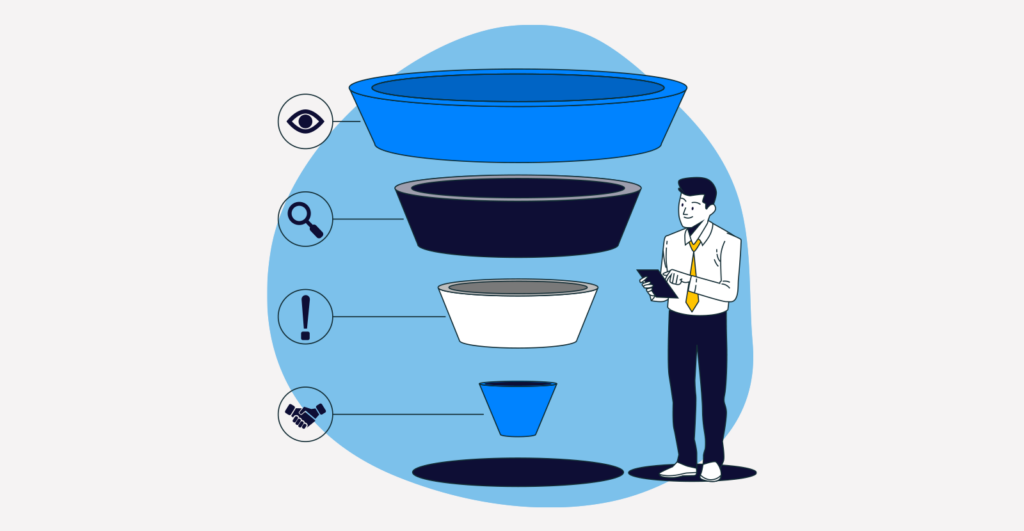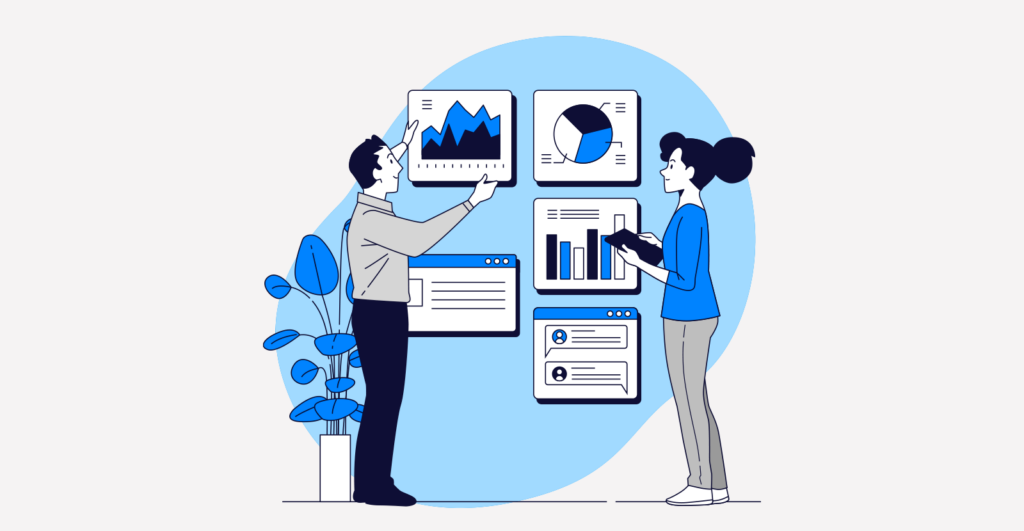“Discover the marketing funnel stages and how tools like Wishpond can optimize your lead conversion strategy.”
The concept of the marketing funnel is pivotal in any business strategy. It guides the journey of a potential customer from being a mere prospect to a loyal customer. This transformation isn’t accidental; it involves a series of calculated steps designed to nurture and convert leads. In this blog, we’ll explore the intricacies of the marketing funnel, delve into its stages, and understand how tools like Wishpond can enhance your marketing efforts.
What is a Marketing Funnel?

The marketing funnel, also known as a sales funnel, is a visual representation of the customer journey. It outlines the stages a prospect goes through before making a purchase. The funnel metaphorically narrows, signifying the gradual decrease in the number of prospects as they move closer to the final purchase decision. This model helps marketers understand the customer’s mindset and tailor their strategies accordingly.
The Stages of a Marketing Funnel
1. Awareness
The awareness stage is at the top of the funnel (TOFU). Here, potential customers realize they have a problem or need. Your goal at this stage is to attract their attention. Content marketing, social media, SEO, and paid advertisements are effective methods to raise awareness. Your content should educate and inform without being overly promotional.
2. Interest
Once prospects are aware of their problem, they enter the interest stage. They begin to seek out more information and explore potential solutions. This is where you establish your brand as a credible source. Blog posts, eBooks, webinars, and informative videos work well in this stage. You aim to build trust and demonstrate your expertise.
3. Consideration
In the consideration stage, prospects evaluate different solutions. They compare products or services and consider factors such as price, features, and benefits. Providing detailed product descriptions, case studies, and comparisons helps them in their decision-making process. This is also the stage where nurturing leads becomes crucial. Email marketing and retargeting ads can keep your brand top-of-mind.
4. Intent
At this stage, prospects show clear interest in your product or service. They may fill out forms, request quotes, or add products to their shopping cart. Your focus should shift to addressing any remaining objections or concerns. Offering demos, free trials, or consultations can help nudge them closer to making a purchase.
5. Purchase
The purchase stage is the goal of the funnel. It’s where prospects convert into paying customers. A seamless checkout process, clear call-to-action, and excellent customer support are essential. However, the journey doesn’t end here. Post-purchase engagement is crucial for fostering loyalty and encouraging repeat business.
6. Retention and Advocacy
After purchase, the focus shifts to customer retention and advocacy. Satisfied customers can become brand advocates, spreading positive word-of-mouth and referring others. Engage them through loyalty programs, personalized offers, and consistent communication. Encourage them to share their experiences and provide feedback.
Enhancing Your Funnel with Wishpond

Wishpond is a powerful tool that can optimize your marketing funnel. It offers a suite of tools designed to attract, nurture, and convert leads. Here’s how Wishpond can be integrated into each stage of the funnel:
1. Lead Generation and Awareness
Wishpond’s landing page builder and pop-ups are excellent for capturing leads at the awareness stage. Customizable templates and forms can be tailored to your target audience, enhancing your lead-generation efforts.
2. Nurturing Leads
Wishpond’s email marketing tools help nurture leads in the interest and consideration stages. Automated email campaigns can deliver personalized content, keeping prospects engaged and informed.
3. Conversion Optimization
For the intent and purchase stages, Wishpond offers conversion tools like forms, contests, and promotions. These tools can incentivize action and make the transition from intent to purchase smoother.
4. Analytics and Retargeting
Wishpond’s analytics provide valuable insights into your funnel’s performance. You can track conversions, understand customer behavior, and refine your strategies. Additionally, its retargeting tools help you reach out to prospects who haven’t yet converted, keeping your brand in their minds.
Common Pitfalls in Managing a Marketing Funnel

Managing a marketing funnel involves more than just understanding its stages. Avoiding common pitfalls can make a significant difference in your conversion rates:
1. Ignoring the TOFU Stage
Neglecting the awareness stage can limit the number of prospects entering your funnel. Invest in SEO, content marketing, and social media to attract a broad audience.
2. Failing to Nurture Leads
Not all leads are ready to buy immediately. Failing to nurture them can result in lost opportunities. Implement email campaigns and personalized content to keep them engaged.
3. Overcomplicating the Funnel
A complex funnel with too many stages or steps can confuse prospects. Keep the journey straightforward and user-friendly.
4. Lack of Personalization
Generic messaging can deter prospects. Personalize your communication to address specific needs and preferences.
5. Ignoring Analytics
Without analyzing data, it’s challenging to identify what’s working and what isn’t. Regularly review your funnel’s performance and adjust your strategies accordingly.

Conclusion
The marketing funnel is a crucial framework for understanding and optimizing the customer journey. By recognizing the stages and implementing the right strategies, businesses can effectively attract, nurture, and convert leads. Tools like Wishpond can significantly enhance these efforts, providing comprehensive solutions for each funnel stage. Avoiding common pitfalls and continuously refining your approach will help maximize the funnel’s efficiency, ultimately leading to increased sales and customer loyalty.
Understanding and managing a marketing funnel requires ongoing effort and adaptation. The market and consumer behaviors are constantly evolving, making it essential to stay updated with the latest trends and technologies. By leveraging powerful tools like Wishpond and adhering to best practices, businesses can navigate the complexities of the funnel with greater ease and success.
FAQs
What is a marketing funnel?
A marketing funnel is a visual model that represents the stages a prospect goes through before making a purchase, from awareness to conversion and beyond.
How can I improve the top of my marketing funnel?
Focus on increasing awareness and attracting leads. Use SEO, content marketing, and social media to reach a broader audience.
Why is lead nurturing important?
Lead nurturing builds relationships with potential customers, guiding them through the consideration stage to conversion. It helps keep your brand top-of-mind and addresses any objections.
How does Wishpond help in managing a marketing funnel?
Wishpond offers tools for lead generation, email marketing, conversion optimization, and analytics. These tools help streamline the funnel and improve conversion rates.
What are common mistakes in managing a marketing funnel?
Common mistakes include neglecting the awareness stage, failing to nurture leads, overcomplicating the funnel, lacking personalization, and ignoring analytics.
How can I measure the effectiveness of my marketing funnel?
Use analytics tools to track metrics like conversion rates, bounce rates, and lead quality. This data helps refine your strategies and improve funnel efficiency.
